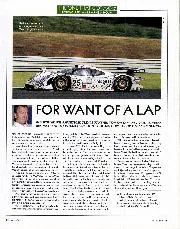Kremer strengthened the aluminium spaceframe, modified the suspension and, most significantly, altered the aerodynamics of this short tail or kurzheck car. The Kremer chassis retained the look of a 917K, albeit more slabsided, but little original bodywork was retained bar the cockpit section. “Apart from the windscreen and doors, everything was custom-made,” explains Achim Stroth, team manager at Kremer for a quarter of a century. “We were trying to bring the concept up to date, but we never went into a wind tunnel.” The short time available for the build process wasn’t the only problem faced by Kremer Racing if it was to make June’s Le Mans, the last time large-capacity Group 6 cars would be eligible. The money also had be found to fund the assault.
The first port of call was the German drinks company that adorned the side of its 935 K3s in the domestic DRM Group 5 series. “I had a picture taken of myself and Bob holding up the chassis with Manfred inside holding a bottle of Jaegermeister,” says Erwin. “Unfortunately they weren’t interested.” Coverage of the project in France attracted the interest of Toulouse property company Malardeau. It provided the lion’s share of the budget along with BP France, but there was a drawback: French amateur drivers Xavier Lapeyre and Guy Chasseuil came with the money.
The Kremer replica — now designated 917K-81 — made it to Le Mans but with less then 50 miles of testing under its belt after the briefest of shakedowns at the Nurburgring. This lack of testing cost the team dear when they arrived in France. “Part of our problem was that the two drivers of, let’s say, medium talent, needed a lot of track time in that kind of machine,” explains Stroth. “I’m sure that if we could have kept Bob in the cockpit we would have sorted it out”

